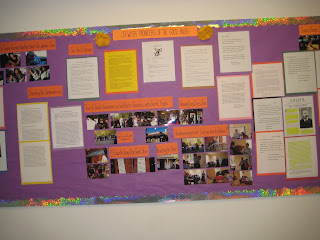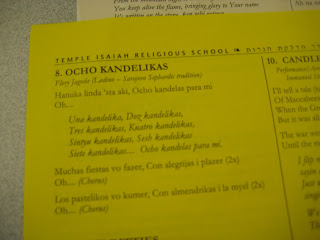The day of our field trip to Sonora and Columbia in the Mother Lode country finally arrived yesterday. The weather was perfect all day long - sunny, in the mid-50's (except for the evening - when the sun set at 4:42 p.m., and it turned very chilly very quickly!). The information sent out to all the participants promised that we would leave precisely at 9 a.m., and that's exactly what we did. Everyone arrived in good time...
 |
| Except for these two who had to make a run for it ! |
|
|
|
and we settled in for the 2-1/4 hour drive to Sonora on the comfortable coach (the air-conditioned, motorized kind!). I introduced everyone to the background history of the Jewish pioneers who eventually settled in northern California, with the help of readings in the information packet given to each family. First, we got into the proper mood for the day by singing a couple of Gold Rush era songs ("Oh California" sung to the tune of "Oh Susanna" and "Clementine"). Parents were then asked to read excerpts to their children from the memoir of Moses Bruml and from a letter written by Hannah Hirschfelder, describing their sea journeys to California from Europe. A third excerpt they read to their children was from I.J. Benjamin's description of the boat and wagon trip to Sonora from San Francisco (a two-week journey in those days!).


 |
|
 |
|

Then it was time to sit back and watch a 42-minute film directed by Bill Chayes, a local filmmaker, called "Birth of a Community: Jews and the Gold Rush." It's a terrific documentary film, which really shared a lot of information that the students could use for the assignment I gave them as soon as the film was over.
I asked each student to "become" a Jewish pioneer buried in the Sonora Pioneer Jewish Cemetery that we would be visiting that afternoon, and to write a "letter home," describing their journey to California, how they earned their living in Sonora, and how they maintained their Jewish identity there. Some students were assigned pioneers whose lives were very well documented, so they had a lot of material to work with for writing their letters. Other students were assigned pioneers whom we know so little about that only their gravestones provided information. In those cases, the students were encouraged to make up information to bring the pioneer "to life" by using information we learned in class and in the film to fill in the gaps.
I'm always amazed at the quality of the letters the students write in the hour or so left before we arrive in Sonora. This year was no exception. Here's an example:
November 3, 1869
Dear Mother and Father,
It has been ten years since I have landed in the Gold Land, but all of my memories still seem young. Since I traveled alone on my treacherous journey, I was very lonely on the way over. Life didn't seem complete without my sister, so I decided to make this long journey.
As you know, our life in Germany was OK. They did not let us practice some customs, but the real reason I left was because I missed my dearest sister so much, and needed to see her.
I sailed first from Germany to New York. Then, I took a steam boat named the "New Orleans" from New York to Panama. We had to hike and take a canal boat to get through the Isthmus to the Pacific coast. We then had to wait for two weeks for another boat to come and pick us up. The maximum people allowed on the ship was supposed to be 400, but 1,000 people were crammed into one ship. We finally arrived in San Francisco in 1859. I didn't stay there long, and I almost automatically moved to Sonora. There, I met my husband, Mayer Baer, and now have seven beautiful children. One died.
My life is amazing in Sonora. I make a good living, selling hand-knit hats, and we are the Jewish center of the town. I am still very religious. My husband takes the role of a rabbi. He leads services, marries people, etc. My children help in the store, and I get to see my dear sister often.
I wish to see you soon, mother and father. I do miss you.
With much love from your dearest daughter,
Helena (Oppenheimer Baer)
We reached Woods Creek Rotary Park in Sonora around 11 a.m., and enjoyed a picnic lunch. Since we still had 1-2-3-4 cakes left that the students had made the previous Sunday, I "sawed" a couple of them into enough pieces for us all (they're that dense!), and we enjoyed their sweet taste. Somehow they seemed to taste even better outdoors on a sunny day in Gold Country. We boarded the bus again (and those who drove themselves got back in their cars) around noon, and headed to Columbia State Historic Park where we were met on Main Street by Frank Cimino, who has been docenting at the Park for a number of years. He shared a general history of the Gold Rush times with our entire group (57 of us in all), then we divided into 3 smaller groups for three stations. While one group learned about the Jewish pioneer merchants in Columbia, people like Shalom and Harris Levy, Joel Levy, Phillip Schwartz, and Rose Levy, the second group climbed the hill up to the old Columbia school house and were taught a lesson that children back in 1861 might have been taught, using slates and chalk. The third group had time to themselves to explore the stores along Main Street. Or, if they wished (and some did!), they could ride the Wells Fargo stagecoach or pan for gold (that water was really COLD!).
By 3 p.m. it was time to drive back to Sonora, to visit its pioneer Jewish cemetery, the earliest Jewish cemetery in the area (the first burial was Hartwig Caro, a 17-year old boy, who died and was buried in 1853). After I gave a brief introduction about the Commission for the Preservation of Pioneer Jewish Cemeteries and Landmarks in the West, which maintains seven pioneer Jewish cemeteries in the Mother Lode region including Sonora's, I handed out a treasure hunt. Families had to find symbols on the gravestones like wilting flowers and broken tree limbs (representing people who died too young), certain Hebrew letters like "pey" "nun" at the top of almost all the gravestones (initials standing for the Hebrew words "poh nikbar" meaning "here is buried"), lambs (representing children who died), and fraternal organization symbols for the Masons and Oddfellows, to which many Jewish men belonged in those days (and still do today, for that matter). Up until a few years ago, we used to do gravestone rubbings, but the stones are now much too fragile for that activity, so the treasure hunt replaced it.
Students shared what they had learned about the people buried in the cemetery and finally, before we left, we all said the Mourner's Kaddish together and put pebbles on the gravestones as a sign that we remember and care about the people buried here. Some members of our group, according to Jewish law, washed their hands before leaving the cemetery in the washbasin provided. Then it was time to head back to Lafayette. We said goodbye to the families who drove on their own, and headed back to the bus.
During our drive home, we watched the two-hour film, "The Frisco Kid" starring Gene Wilder and Harrison Ford. It was a perfect wrap-up for our day. The film tells the story of a Polish rabbi who is sent to San Francisco with a Torah scroll, to become the newly formed Jewish community's rabbi there in 1850. On the way, he encounters many difficulties, not the least of which is trying to preserve his Jewish beliefs and rituals in the wild west. Harrison Ford plays the bank robber who befriends him, and gets him out of quite a few situations. The film ended just 10 minutes before we arrived back in Lafayette, the end to a perfect day.
 |
| Frank, our docent, with the hat |
|
 |
| Frank with one of the three groups - notice the Wells Fargo stagecoach in the background |
|
 |
| Phillip Schwartz's "New York Fancy Dry Goods Store" |
 |
| Inside Phillip Schwartz's store, you can buy things that the pioneers bought back in Gold Rush days |
 |
| Girls and boys lined up separately back in 1861 to enter the classroom (they also had separate play areas for recess) |
 |
| History Lesson |
 |
| If you can't behave, you sit for an hour or more with the Dunce Cap on (notice the map in the background - only 33 states back in 1861) |
 |
| Misbehave a second time, and get your palm slapped hard with a ruler |
 |
| Gathering at the Sonora Pioneer Jewish Cemetery |
 |
| Looking for the letters "pey" "nun" as part of the Treasure Hunt |
|
|
|
|
|
 |
| Continuing the search for symbols on the gravestones |
 |
| Discovering Felix Edgar Dreyfous' gravestone, whose wife had inscribed on it, "To live in hearts we leave behind is not to die." |
|
So as not to end this post on a sad note, I thought I'd share the following photo I took of a sign hanging in one of the saloons on Main Street in Columbia. It wasn't only during the Gold Rush days that times were rough!




















































